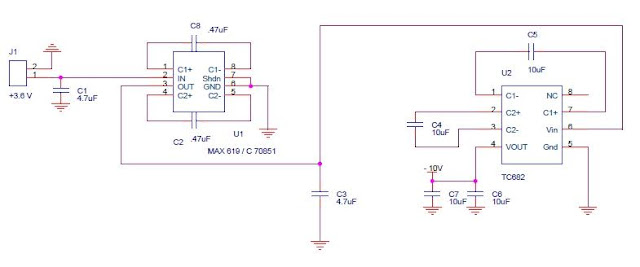This power supply circuit contains two charge-pump DC-DC converters which can delivery up to -10V for a 2,0V to 3,6V input voltage battery. For a current consumption of 7mA the output voltage it will drop to 9V, but this is enough to power a portable handheld instrument. The overall efficiency it will be up to 74% for a 2V input voltage and 60% for a 3.6V lithium polymer battery cell.
First charge-pump DC-DC converter based on MAX 619 from Maxim , C70851 smd code , delivers a regulated 5V +/- 4% output at max. 50mA. To maintain the greatest efficiency over the entire input voltage range, the MAX619's internal charge pump operates as a voltage doubler when input voltage ranges from 3.0V to 3.6V, and as a voltage tripler when it ranges from 2.0V to 2.5V.
The second charge pump converter use a TC682 circuit from Microchip and it provides an inverted doubled (-10V) output from a single positive supply (+5V regulated). An on-board 12kHz (typical) oscillator frequency provides the clock and only 3 external capacitors are required for full circuit implementation. Low output source impedance (typically 140Ω), provides output current up to 10mA.
The second charge pump converter use a TC682 circuit from Microchip and it provides an inverted doubled (-10V) output from a single positive supply (+5V regulated). An on-board 12kHz (typical) oscillator frequency provides the clock and only 3 external capacitors are required for full circuit implementation. Low output source impedance (typically 140Ω), provides output current up to 10mA.

- 5V dc-dc converter this circuit can deliver over 1.6A at 5V and still work at 2.0V
- Max761 boost converter module from 5V to 13.5V or 12V, ideal for Flash Memory Programming






0 comments:
Post a Comment